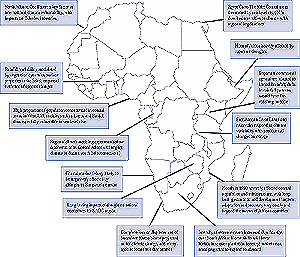|
5. Regional Analysis
The vulnerability of human populations and natural systems to climate change
differs substantially across regions and across populations within regions.
Regional differences in baseline climate and expected climate change give rise
to different exposures to climate stimuli across regions. The natural and social
systems of different regions have varied characteristics, resources, and institutions
and are subject to varied pressures that give rise to differences in sensitivity
and adaptive capacity. From these differences emerge different key concerns
for each of the major regions of the world. Even within regions, however, impacts,
adaptive capacity, and vulnerability will vary. Because available studies have
not employed a common set of climate scenarios and methods and because of uncertainties
regarding the sensitivities and adaptability of natural and social systems,
assessment of regional vulnerabilities is necessarily qualitative.
5.1. Africa

Figure TS-6: Selected key impacts for Africa. |
Africa is highly vulnerable to climate change.
Impacts of particular concern to Africa are related to water resources, food
production, human health, desertification, and coastal zones, especially in
relation to extreme events. A synergy of land-use and climate change will exacerbate
desertification. Selected key impacts in Africa are highlighted in Figure
TS-6.
5.1.1. Water Resources
Water resources are a key area of vulnerability in Africa, affecting water
supply for household use, agriculture, and industry. In shared river basins,
regional cooperation protocols minimize adverse impacts and potential for conflicts.
Trends in regional per capita water availability in Africa over the past half
century show that water availability has diminished by 75%. Although the past
2 decades have experienced reductions in river flows, especially in sub-Saharan
West Africa, the trend mainly reflects the impact of population growth—which,
for most countries, quadrupled in the same period. Population growth and degradation
of water quality are significant threats to water security in many parts of
Africa, and the combination of continued population increases and global warming
impacts is likely to accentuate water scarcity in subhumid regions of Africa.
Africa is the continent with the lowest conversion factor of precipitation
to runoff, averaging 15%. Although the equatorial region and coastal areas of
eastern and southern Africa are humid, the rest of the continent is dry subhumid
to arid. The dominant impact of global warming will be a reduction in soil moisture
in subhumid zones and a reduction in runoff. Current trends in major river basins
indicate decreasing runoff of about 17% over the past decade.
Most of Africa has invested significantly in hydroelectric power facilities
to underpin economic development. Reservoir storage shows marked sensitivity
to variations in runoff and periods of drought. Lake storage and major dams
have reached critical levels, threatening industrial activity. Model results
and some reservoirs and lakes indicate that global warming will increase the
frequency of such low storage as a result of flooding or drought conditions
that are related to ENSO. [10.2.1]
5.1.2. Food Security
There is wide consensus that climate change will worsen food security, mainly
through increased extremes and temporal/ spatial shifts. The continent already
experiences a major deficit in food production in many areas, and potential
declines in soil moisture will be an added burden. Food-insecure countries are
at a greater risk of adverse impacts of climate change. Inland and marine fisheries
provide a significant contribution to protein intake in many African countries.
As a result of water stress and land degradation, inland fisheries will be rendered
more vulnerable to episodic drought and habitat destruction. Ocean warming is
likely to impact coastal marine fisheries. [10.2.2]
5.1.3. Natural Resource Management and Biodiversity
Irreversible losses of biodiversity could be accelerated with climate change.
Climate change is expected to lead to drastic shifts of biodiversity-rich biomes
such as the Succulent Karoo in South Africa and many losses in species in other
biomes. Changes in the frequency, intensity, and extent of vegetation fires
and habitat modification from land-use change may negate natural adaptive processes
and lead to extinctions. Changes in ecosystems will affect water supply, fuelwood,
and other services. [10.2.3.2]
|